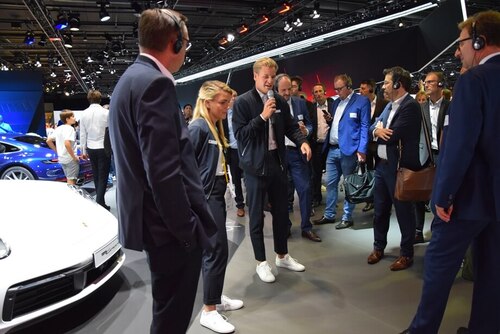Thursday, November 21, 2019
IAA buyers’ day: staying mobile in purchasing

Doris Hülsbömer BME e.V.
The transformation of the automotive industry was clearly visible at the International Motor Show (IAA) in Frankfurt. „This IAA differs from other trade fairs in that it includes start-ups and new mobility concepts. In addition, the entire value chain is represented at the IAA,“ emphasised Dr. Joachim Damasky, Technical Director of the VDA at the 2nd BME/VDA Buyers’ Day at the IAA in September. Around 90 participants discussed with experts at the sold-out event and were able to gain interesting impulses from the keynote speeches.* VDA and BME jointly launched this exchange platform, the first edition took place in 2018 at the IAA Commercial Vehicles in Hanover. In addition to presentations by experts, buyers were also given insights into studies such as VW's ID.3 at the exhibition grounds and into an autonomously operating chassis from Schaeffler. A special highlight on the tour was the new all-electric Taycan from Porsche.
“No industry has designed purchasing as professional as the automotive industry,” said BME Managing Director Dr. Silvius Grobosch in his opening remarks. Due to a value added depth of 80 percent, purchasing in the automotive industry is of particular importance. Driven by joint product development between OEMs and suppliers, their close integration is a must. “This will also apply to e-mobility.”
Large footsteps for the automobile
At this year's motor show, the turning point is within reach. Dialogues, networking and new drive concepts with alternative drives dominate the action. The industry signals its willingness to engage in dialogue with all those involved. It is unlikely to work any other way. In the four future scenarios of the automotive industry presented by David Heider, Senior Manager Sourcing and Procurement at Deloitte, the OEMs are downgraded to mere suppliers of a very strong end customer in a future scenario (scenario 4). Purchasing is limited to further separating operational and strategic purchasing and acting along these guidelines. When Prof. Moritz Peter of Pforzheim University of Applied Sciences, moderator of the event, had the participants voting on the most probable scenario, the most votes for this variant were found next to scenario 1. After all: In scenario 1, purchasing becomes the innovation engine and manages a heterogeneous team in a highly efficient automotive supply chain; the OEMs retain their leading position.
Bad bank for suppliers
The changes in the automotive industry also lead to increasing volatility and complexity for suppliers, which can cause high costs in purchasing. “We do see an increase in vulnerable suppliers and escalations,” said Dr. Michael Karrer of ZF Friedrichshafen. Rising costs in escalation processes, such as short-term relocations, have prompted ZF to develop innovative solutions. One of these concepts is based on the concept of a “bad bank” from the financial sector. For the critical supplier, non-lucrative small volumes are preventively shifted to a specialized manufacturer. In addition, Dr. Karrer also pointed out success factors in risk management, such as the focused use of resources and fast decision-making processes.
AI as office assistant
With the Group Procurement Suite (GPS), Volkswagen's Group Procurement aims to set a global benchmark for purchasing systems in terms of efficiency, consistency and operation. In the first stage, 18 of the 48 core procurement systems across the Group will be replaced by the new solution. These are currently responsible for 65 percent of operating costs. Parallel to GPS, Volkswagen is pursuing an innovative approach with digital value-added projects to leverage short-term benefits in purchasing and test new technologies. “A bidder list generator developed in-house uses machine learning to identify potential suppliers that fit perfectly,” explained Jens Fraterman, who is responsible for Digital Innovations at Volkswagen Group Procurement. Also new is the widespread use of Robotic Process Automation (RPA) in procurement processes. “A bot processes the award decision for new parts and automatically generates an order proposal for the buyer,” says the digitization expert. This eliminates the need for the purchaser to create orders manually.
New focus at Porsche
“We need to know which core competencies will continue to make us strong in the future,” said Olaf Bollmann, who is responsible for strategic purchasing processes at Porsche. Customers would expect new networks to be created more quickly. This would increase the complexity of procurement. “Some of our partners come from completely different industries, resulting in new tasks in the cooperation. Networks would become more complex. But: “Who, if not procurement, should manage that?” In addition to cooperations and partnerships, purchasing is also involved in M&A, as in Porsche's recent participation in the Croatian electric car start-up Rimac.
* Doris Hülsbömer, BME, reported from the 2nd BME / VDA Buyers’ Day